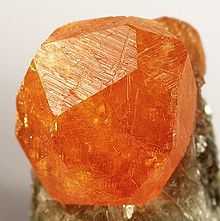Spessartine
| Spessartine | |
|---|---|
 Spessartine from China | |
| General | |
| Category | Nesosilicate |
| Formula (repeating unit) | Mn2+3Al2(SiO4)3 |
| Strunz classification | 09.AD.25 |
| Crystal symmetry |
Isometric hexoctahedral H-M symbol: (4/m 3 2/m) Space group: I a3d |
| Unit cell | a = 11.63 Å; Z=8 |
| Identification | |
| Color | Yellow through red |
| Crystal habit | Massive to crystalline |
| Crystal system | Isometric |
| Cleavage | None |
| Fracture | Sub conchoidal |
| Tenacity | Brittle |
| Mohs scale hardness | 6.5 - 7.5 |
| Luster | Vitreous |
| Streak | White |
| Diaphaneity | Transparent to translucent |
| Specific gravity | 4.19 calculated, 4.12 - 4.32 measured |
| Optical properties | Isotropic, often anomalous double refractive |
| Refractive index | 1.800 |
| Birefringence | none |
| Dispersion | Weak |
| Absorption spectra | Bands at 410, 420, 430nm (or merging to form cutoff below 430nm; also bands at 460, 480, 520nm. Possible weak bands at 504, or 573nm [1] |
| References | [2][3][4] |
Spessartine or spessartite, is a nesosilicate, manganese aluminium garnet species, Mn2+3Al2(SiO4)3.[1][2][3][4]
The name is a derivative of Spessart in Bavaria, Germany, the type locality of the mineral.[2][3] It occurs most often in granite pegmatite[2][3][4] and allied rock types and in certain low grade metamorphic phyllites. Sources include Australia, Myanmar, India, Afghanistan, Israel, Madagascar, Tanzania and the United States.[1] Spessartine of an orange-yellow has been called Mandarin garnet and is found in Madagascar. Violet-red spessartines are found in rhyolites in Colorado and Maine. In Madagascar, Spessartines are exploited either in their bedrock or in alluvium. The orange garnets result from sodium rich pegmatites. Spessartines are found in bedrock in the highlands in the Sahatany valley. Those in alluvium are generally found in southern Madagascar or in the Maevatanana region.[5][6][7][8][9]
Spessartine forms a solid solution series with the garnet species almandine.[3][4] Well formed crystals from this series, varying in color from very dark-red to bright yellow-orange were found in Latinka, Rhodope Mountains, Kardzhali Province, Bulgaria.[10]
See also
- garnet
- almandine
- andradite
- grossular
- pyrope
- tsavorite
- uvarovite
- geology
- mineral collecting
- mineral
- gemstone
References
- ↑ 1.0 1.1 1.2 Gemological Institute of America, GIA Gem Reference Guide 1995, ISBN 0-87311-019-6
- ↑ 2.0 2.1 2.2 2.3 Webmineral Spessartine page
- ↑ 3.0 3.1 3.2 3.3 3.4 Mindat Spessartine page
- ↑ 4.0 4.1 4.2 4.3 Handbook of Mineralogy Spessartine page
- ↑ "Gem News". Gems & Gemology 34 (1): 50–63. 1998-04-01. doi:10.5741/GEMS.34.1.50. Retrieved 2012-04-08.
- ↑ Shigley, James; Dona Dirlam, Brendan Laurs, Edward Boehm, George Bosshart, William Larson (2000). "Gem localities of the 1990s". Gems & Gemology 36 (4): 292–335. doi:10.5741/GEMS.36.4.292. Retrieved 2012-04-08.
- ↑ Laurs, Brendan; Kimberly Knox (2001). "Spessartine garnet from Ramona, San Diego County, California". Gems & Gemology 37 (4): 278–295. doi:10.5741/GEMS.37.4.278. Retrieved 2012-04-08.
- ↑ Rossman, George R. (2009). "The geochemistry of gems and its relevance to gemology: different traces, different prices". Elements 5 (3): 159–162. doi:10.2113/gselements.5.3.159. ISSN 1811-5209. Retrieved 2012-04-08.
- ↑ Schmetzer, Karl; Thomas Hainschwang, Lore Kiefert, Heinz-Jürgen Bernhardt (2001). "Pink to pinkish orange Malaya garnets from Bekily, Madagascar". Gems & Gemology 37 (4): 296–308. doi:10.5741/GEMS.37.4.296. Retrieved 2012-04-08.
- ↑ "Spessartine from Latinka, Bulgaria:".

| ||||||||||||||||||||||||||||